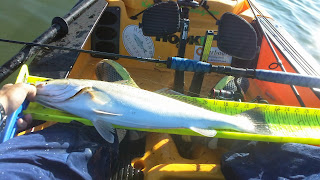I'm going to cover some of the basic tackles, lures, and techniques for targeting these beautiful fish here in Maryland. This will definitely give you enough intel to get out there and try it yourself. You may not tear them up right away, but half the battle is putting in the time and learning the hard way.
Tackle Choices:
I suggest a 6'6" - 7' Medium to MH rod with fast action. You want a rod that will give some when the trout hits providing less resistance allowing the fish to eat the bait and not be deterred by the stiffness of the rod. I use two 6' rods just because that's what I have, but they would be a little bit better if they were 6'6".
I personally use:
7' Medium Overboard Bobber Series Casting Rod with a Shimano Curado 201E7 (Trolling and Casting)
6'6" Medium Heavy Overboard Soul Pole Rod (Casting)
2 - 6' Medium Overboard Bobber Series Spinning Rods (Trolling)
Perfect example of the rod I use, paired with a Shimano Stradic Ci4 3000 w/ 20lb braid. I also like to use 3-5 feet of fluorocarbon leader tied with a Half Albright Knot. I tie the leader to the hook with a Canoeman's Loop Knot
It is important to have a reel with a smooth drag. Trout have a soft mouth/jaw structure and tend to head shake a lot. A smooth drag will allow the fish to take line easily when it decides to run, which they do often... and not rip the hook from the fish's mouth.
Lure Options:
I've come to be a firm believer in the Saltwater Bass Assassin 4" Paddle Tails. I own almost every color and have had success on most colors. Some days certain colors work better, that is why I work 3 rods initially with 3 different colors, then adjust from there if I notice any pattern. I also like 4" curly tail grubs from time to time as well, mostly when the bluefish aren't around, because they are more easily chewed up. The Zman plastics are a great option if bluefish are present to minimize the amount of lost baits, but personally I like the slightly smaller sized Bass Assassins the most.
4" Bass Assassin w/ 1/8oz jig head
4" Bass Assassin w/ 1/16oz jig head
I strictly use 1/16 - 1/8 oz jig heads or weedless hooks (w/ weighted shank and screw for plastic) for trolling. I personally like pink painted heads the best, then red or chartreuse.
For casting lures I like 1/4oz jig heads or weedless hooks as they allow for great casting distance. I also like to add a spinner arm to my jig heads to add a different look than the baits that I use trolling.
Techniques:
Trolling - Trolling is simple... set out two rods with lures like suggested above and pedal/paddle as slow as you can while keeping your lures from snagging the bottom on grass, oysters, mud, or rocks.
Casting - This is the funnest because you actually get to set the hook on the thump of a trout bite. I cast when there are fish breaking the surface, while fishing around points with moving water and structure and working the shoreline near small outflows of creeks and grassy islands





Matt, never heard of anyone using weighted hooks but that sounds like an awesome idea.....i might have to try that next time i go out. Is there a video somewhere demonstrating how you rig your lures using the weighted hooks?
ReplyDeleteThey are considered swimbait hooks, Gamakatsu makes the nicest IMO, but they are expensive. Here is an example https://www.google.com/search?q=swimbait+hooks&source=lnms&tbm=isch&sa=X&ei=Kd9AUo3qNIWy4AOIjIDYBQ&ved=0CAkQ_AUoAQ&biw=1024&bih=499&dpr=1#facrc=_&imgrc=pt0d4IhSb81doM%3A%3BMEsCvAi9AWc6LM%3Bhttp%253A%252F%252Fwww.elkenlures.com%252Fimages%252Ftackle%252Fwg-swimbait-hooks.jpg%3Bhttp%253A%252F%252Fwww.elkenlures.com%252Fwg-sb-hook.htm%3B300%3B277
DeleteThanks for the tips, Matt. A question for ya is what kind of habitat to look for them in? Are they in shallow water? Do they prefer sandy bottoms, muddy bottoms, rocks, etc? What pattern should we look for?
ReplyDeleteMoving water during the tide is the most important thing. The bite generally shuts off completely during a slack tide. I've caught them from 1-9 feet of water. I follow the surface action (always looking and listening). If it is windy that can be difficult to do, so you kinda just gotta go at it blindly. But Fishing near and further off of points is the best place to start.
Delete